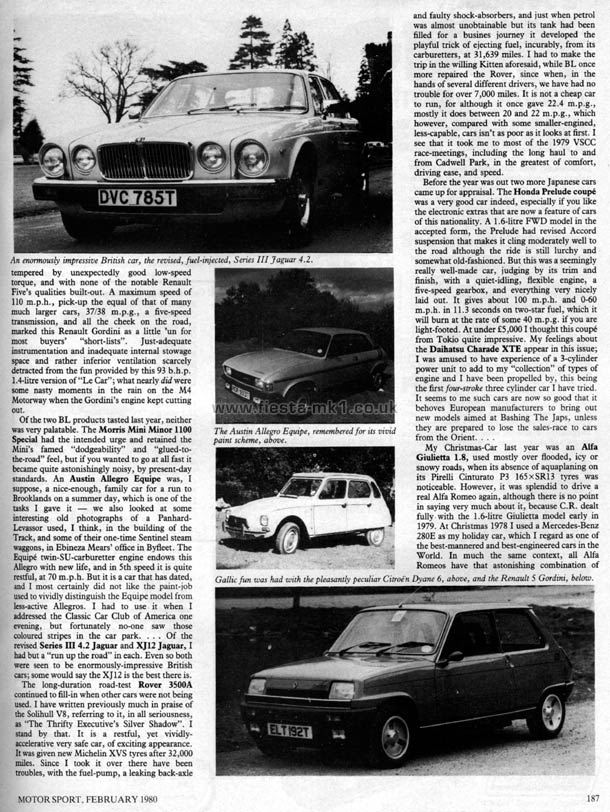Copy of Article Text Below
.....tempered by unexpectedly good low-speed torque, and with none of the notable Renault Five's qualities built-out. A maximum speed of 110 m.p.h., pick-up the equal of that of many much larger cars, 37/38 m.p.g., a five-speed transmission, and all the cheek on the road, marked this Renault Gordini as a little 'un for most buyers' "short-lists". Just-adequate instrumentation and inadequate internal stowage space and rather inferior ventilation scarcely detracted from the fun provided by this 93 b.h.p. 1.4-litre version of "Le Car"; what nearly did were some nasty moments in the rain on the M4 Motorway when the Gordini's engine kept cutting out.
Of the two BL products tasted last year, neither was very palatable. The Morris Mini Minor 1100 Special had the intended urge and retained the Mini's famed "dodgeability" and "glued-to-the-road" feel, but if you wanted to go at all fast it became quite astonishingly noisy, by present-day standards. An Austin Allegro Equipe was, I suppose, a nice-enough, family car for a run to Brooklands on a summer day, which is one of the tasks I gave it - we also looked at some interesting old photographs of a Panhard-Levassor used, I think, in the building of the Track, and some of their one-time Sentinel steam waggons, in Ebineza Mears' office in Byfleet. The Equipe twin-SU-carburetter engine endows this Allegro with new life, and in 5th speed it is quite restful, at 70 m.p.h. But it is a car that has dated, and I most certainly did not like the paint-job used to vividly distinguish the Equipe model from less-active Allegros. I had to use it when I addressed the Classic Car Club of America one evening, but fortunately no-one saw those coloured stripes in the car park. ... Of the revised Series III 4.2 Jaguar and XJ12 Jaguar, I had but a "run up the road" in each. Even so both were seen to be enormously-impressive British cars; some would say the XJ12 is the best there is.
The long-duration road-test Rover 3500A continued to fill-in when other cars were not being used. I have written previously much in praise of the Solihull V8, referring to it, in all seriousness, as "The Thrifty Executive's Silver Shadow". I stand by that. It is a restful, yet vividly-accelerative very safe car, of exciting appearance. It was given new Michelin XVS tyres after 32,000 miles. Since I took it over there have been troubles, with the fuel-pump, a leaking back-axle and faulty shock-absorbers, and just when petrol was almost unobtainable but its tank had been filled for a busines journey it developed the playful trick of ejecting fuel, incurably, from its carburetters, at 31,639 miles. I had to make the trip in the willing Kitten aforesaid, while BL once more repaired the Rover, since when, in the hands of several different drivers, we have had no trouble for over 7,000 miles. It is not a cheap car to run, for although it once gave 22.4 m.p.g., mostly it does between 20 and 22 m.p.g., which however, compared with some smaller-engined, less-capable, cars isn't as poor as it looks at first. I see that it took me to most of the 1979 VSCC race-meetings, including the long haul to and from Cadwell Park, in the greatest of comfort, driving ease, and speed.
Before the year was out two more Japanese cars came up for appraisal. The Honda Prelude coupe was a very good car indeed, especially if you like the electronic extras that are now a feature of cars of this nationality. A 1.6-litre FWD model in the accepted form, the Prelude had revised Accord suspension that makes it cling moderately well to the road although the ride is still lurchy and somewhat old-fashioned. But this was a seemingly really well-made car, judging by its trim and finish, with a quiet-idling, flexible engine, a five-speed gearbox, and everything very nicely laid out. It gives about 100 m.p.h. and 0-60 m.p.h. in 11.3 seconds on two-star fuel, which it will burn at the rate of some 40 m.p.g. if you are light-footed. At under £5,0001 thought this coupe from Tokio quite impressive. My feelings about the Daihatsu Charade XTE appear in this issue; I was amused to have experience of a 3-cylinder power unit to add to my "collection" of types of engine and I have been propelled by, this being the first four-stroke three cylinder car I have tried. It seems to me such cars are now so good that it behoves European manufacturers to bring out new models aimed at Bashing The Japs, unless they are prepared to lose the sales-race to cars from the Orient. . . .
My Christmas-Car last year was an Alfa Giulietta 1.8, used mostly over flooded, icy or snowy roads, when its absence of aquaplaning on its Pirelli Cinturato P3 165xSR13 tyres was noticeable. However, it was splendid to drive a real Alfa Romeo again, although there is no point in saying very much about it, because C.R. dealt fully with the 1.6-litre Giulietta model early in 1979. At Christmas 1978 I used a Mercedes-Benz 280E as my holiday car, which I regard as one of the best-mannered and best-engineered cars in the World. In much the same context, all Alfa Romeos have that astonishing combination of.....
Captions -
Top-Left - An enormously impressive British car, the revised, fuel-injected, Series III Jaguar 4.2.
Middle - The Austin Allegro Equipe, remembered for its vivid paint scheme, above.
Bottom-Right - Gallic fun was had with the pleasantly peculiar Citroen Dyane 6, above, and the Renault 5 Gordini, below.
|






